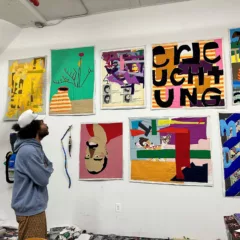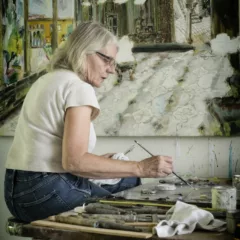Scot Borofsky started as a graffiti artist in the East Village (NYC) and eventually made his way into the museum and commercial gallery art world. His work can be found in the Metropolitan Museum of Art and The Brooklyn Museum of Art, a rare accomplishment for a graffiti street artist. Borofsky’s art combines the depth of tradition with the uncertainty of the contemporary, linking the ages with a sacred line. The work (@Jules Goldman Books and Antiques) may appear to be simple abstractions but Borofsky is giving you the ARCHETYPE, layered. God knows what these images are doing to viewers’ brains. The layering of archetypal line sets Borofsky’s paintings apart from most abstract paintings, and it is worth study. Scot takes a conceptual approach to the historical line, giving it a contemporary purpose. This interview was conducted in person.
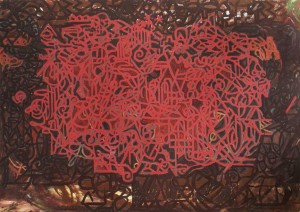
Corey Armpriester– How did you make the migration from street artist to gallery representation?
Scot Borofsky– Magazines and newspapers wrote about my work.
CA- How important is it for artists to travel?
SB- Well, I think if you’re an artist you have to travel. You’re collecting information. You are totally affected by the culture you live in, your idea of life and the world. You really have to go far away from that culture to see it in an objective manner. In my case I’ve traveled largely in third world countries. I’ve seen the other side of life and I owe so much of everything that I know, think and do to what I saw traveling. It’s one of the most important things.
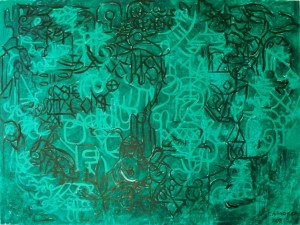
CA- Aztec and Mayan temples have a history of human sacrifice. How did you come to terms with this while living around the temples and being influenced by them aesthetically?
SB-The abstract artistic design rules of that time is my area, I don’t feel like I have to come to terms with that personally. If you go into the Amazon you’re going to find people still engaged with some form of human sacrifice.
CA- Do we [Americans] practice human sacrifice via war?
SB-Absolutely. You can’t justify these things.
CA-Do you practice ancestral worship?
SB-I believe in simultaneous reincarnation, which basically comes down to we are all fragments of the same soul.

CA- What is one quality every artist should posses?
SB- That’s a very difficult question to answer. I think you have to be able to get obsessed over your idea. You have to take your idea to the furthest limits it can possibly go.
CA-What was the greatest lesson you learned while attending high school?
SB-They taught me to believe in myself.
CA-Can you talk about the experience you had with Jean-Michel Basquiat?
SB- I was at a Julian Schnable exhibit [at the Whitney]. I was in a room by myself and suddenly Basquiat walks into the the room. Basquiat started to back-up to the wall while taking a marker out of his pocket, and behind his back he started doing a drawing on the wall, during the opening at the Whitney! And he was looking me in the eye the whole time. He put the marker back into his pocket and then slowly made his way out of the room. You couldn’t make out the image he was trying to draw but you could see Basquiat in the line; you could feel his energy. Thats what helped me find my own style.That was his gift to me. He gave that to me.
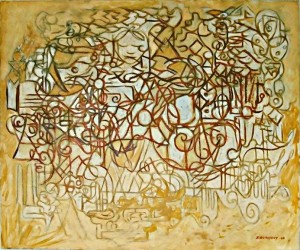
CA- What is your relationship to the symbol?
SB- I was working with collage materials making collage constructions from stuff I found on the streets of Manhattan. They were abstract free-form constructions. A couple of them started to look like what you would call primitive figures or masks. They started to look like a symbol for the figure.
CA- Is the spiral representative of a prison?
SB- I use the spiral in a lot of different situations. The spiral for me means only one thing, It means the first bowl made by human hands.
CA-Are your pyramid step lines about ascension?
SB-The pyramid is definitely about ascension, that is true. I also use the step line in symbols that are figurative, this is actually the origin of the design.
CA- Is your work concerned with the way geometric archetypes affect the human brain?
SB- My work is very concerned with the way lines and shapes are seen by the human brain. For instance if you compare the Roman Arch to the Japanese Pagoda, one line brings you down to earth and the other lifts your spirit up. Those kind of lines I try to incorporate into my symbols. People see art differently depending on how left brained or right brained they are.
CA- Is your work born out of spontaneity?
SB- Some artists will say you have to wait for an accident to happen and then go with it, that’s your open door, the key. I don’t wait for the accident, I create the accident.
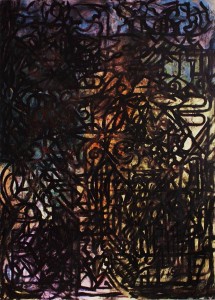
CA- Is art ever finished?
SB- Oh yeah, I think you should never expect an art work to work on the first round. You’ve got to go back to it.
CA-Is it the artist’s responsibility to explore the duality of life?
SB-The artist’s responsibility is to explore life, and then put all of that into the work. That’s what makes art powerful.
CA- Is it possible for the civilized to live amongst the uncivilized?
SB- To me civilized means culture that works.
CA- Should artists attempt escaping influence?
SB- Artists should emulate what they find and are attracted to in art. One day down the line they will see what came from them and not the influence. At this point they can let go of all the influences and just paint what is you.
CA- Do you consider yourself a decorative artist?
SB- Not at all, that’s an insult.
The exhibition runs to December 31, 2011
Jules Goldman Books, 29 N. 2nd St., Philadelphia, PA



